Clean heat: coordinating the transition to low-carbon heat
Using open collaboration to create a blueprint for an ambitious, coordinated approach to decarbonising homes.

The UK currently follows an individual-led approach to low-carbon heating. Households decide on their own whether to switch to low-carbon heating, while governments focus mainly on providing incentives and regulations to encourage people to switch. We think the UK also needs to develop a more coordinated approach to switching homes to low-carbon heat, to sit alongside the current individual-led model. This coordinated approach would mean enabling many households - across a street, neighbourhood or wider area - to switch at the same time. We see this approach as voluntary in most cases. It will allow households to sign up rather than compelling them to, which means it must develop attractive offers.
This project aimed to understand how a coordinated approach could work in practice in the UK. We took a collaborative approach, speaking with stakeholders and hosting workshops around the UK, to explore what processes and structures may be required to enable the planning and delivery of a coordinated approach to the transition.
We have engaged stakeholders including community groups, contractors, policymakers, local and national governments and manufacturers. We have built on their input to develop a policy blueprint with a high-level summary below.
Coordinated switching - a householder journey.
How would our suggested coordinated approach to low-carbon heat benefit households? Let's take a look at an example and how it compares to the current individual approach.
Awareness
A coordinated approach: I have seen messages about the nationwide switch to low-carbon heat.
Current individual approach: We rely on households finding out about heat pumps or other low-carbon heat on their own.
Local consultation
A coordinated approach: I see adverts on my local authority’s social media and receive a letter about a consultation to determine the most suitable future heating technology for my home.
Current individual approach: Households have to be motivated to start researching low-carbon heat.
Direction setting
A coordinated approach: I receive a letter notifying me that the zoning consultation is live. My home is designated to be in an air source heat pump zone.
Current individual approach: There is no clear guidance on what may be the most suitable technology for their home.
“Consumers should have better access to knowledge. Consumers are too dependent on suppliers providing honest advice.”
Technical awareness
A coordinated approach: I receive an email from the local heat agency about plans for the heat transition in my street, and read guidance provided on what an air source heat pump is and how it works.
Current individual approach: A householder has to be proactive in sourcing, sometimes conflicting, advice that can make navigating options difficult.
A specific offer
A coordinated approach: I receive a letter from the local heat agency about a collective purchasing offer. It indicates how much this could cost and gives a point of contact for more information.
Current individual approach: Households have to navigate a complex landscape of subsidies, consumer offers and providers.
“I’m not sure how to access the boiler upgrade scheme – I just know it is £7,500. I had some adverts on Instagram – I didn’t click on the links though. There are always little asterisks which suggests to me that you need to qualify for the grant based on income levels.”
Dedicated advice
A coordinated approach: I discuss my options with an advisor at the local heat body, including alternatives to the current offer and advice on associated home upgrades and subsidies.
Current individual approach: It is difficult to find trusted advice – when advice is found it can be conflicting.
Tailored Quote
A coordinated approach: After a heat loss survey, I receive a detailed offer from a heat pump supplier, including the price. Considering my boiler's age I decide to accept the introductory offer.
Current individual approach: By this stage in the process the household has had a lot of involvement in sourcing installers and receiving competitive quotes. Getting to a price for work takes considerable effort.
"I don’t mind paying more if the work is more, or if the work is done well...but it’s difficult to find an installer I trust”
Installation
A coordinated approach: The supplier arranges for an engineer to install the heat pump and any necessary upgrades. I’m informed about maintenance requirements and aftercare.
Current individual approach: Installation may look similar, however aftercare and maintenance can be patchy and vary vastly.
“We took our time finding a reputable MCS-accredited installer which gave us confidence that the system would be the correct size, installed correctly, and more importantly had a good warranty and that the installer would sign us up to become one of their maintenance customers.”
The benefits for households
Increasing awareness
Raising awareness early at both a national and local level. Direction setting at both scales and giving clear signals on how to engage.
Creating certainty
Presenting specific delivery options and consumer offers that relate to the local context. Enabling shared schemes to identify areas of demand.
Reducing household effort
Reducing the effort required by households to source contractors and understand technical elements of the work. Presenting homes with better options to connect to shared infrastructure.
The key groups involved
A coordinated switching approach is likely to involve new institutions or new roles for existing institutions. We have split the institutions needed into five groups that we call personas. We have not specified the exact form these organisations should take here, but we have set out the role, skill sets and resources required for these bodies to be effective. The groups are:

National planning and governance
The existing organisations that would resource, regulate or work in supporting areas for a national heat transition unit and local heat planning.

National Heat Transition Unit
A new entity that oversees the nationwide decarbonisation of heat. It has targets for homes to be switched to low-carbon heating and its main role is to support, resource and provide guarantees to local heat bodies.

Local heat body
A new local government organisation produces plans at a local, granular level, identifying the right technology for the right areas, identifying areas suitable for coordinated switching, procuring delivery for areas and ensuring that citizens are involved throughout.
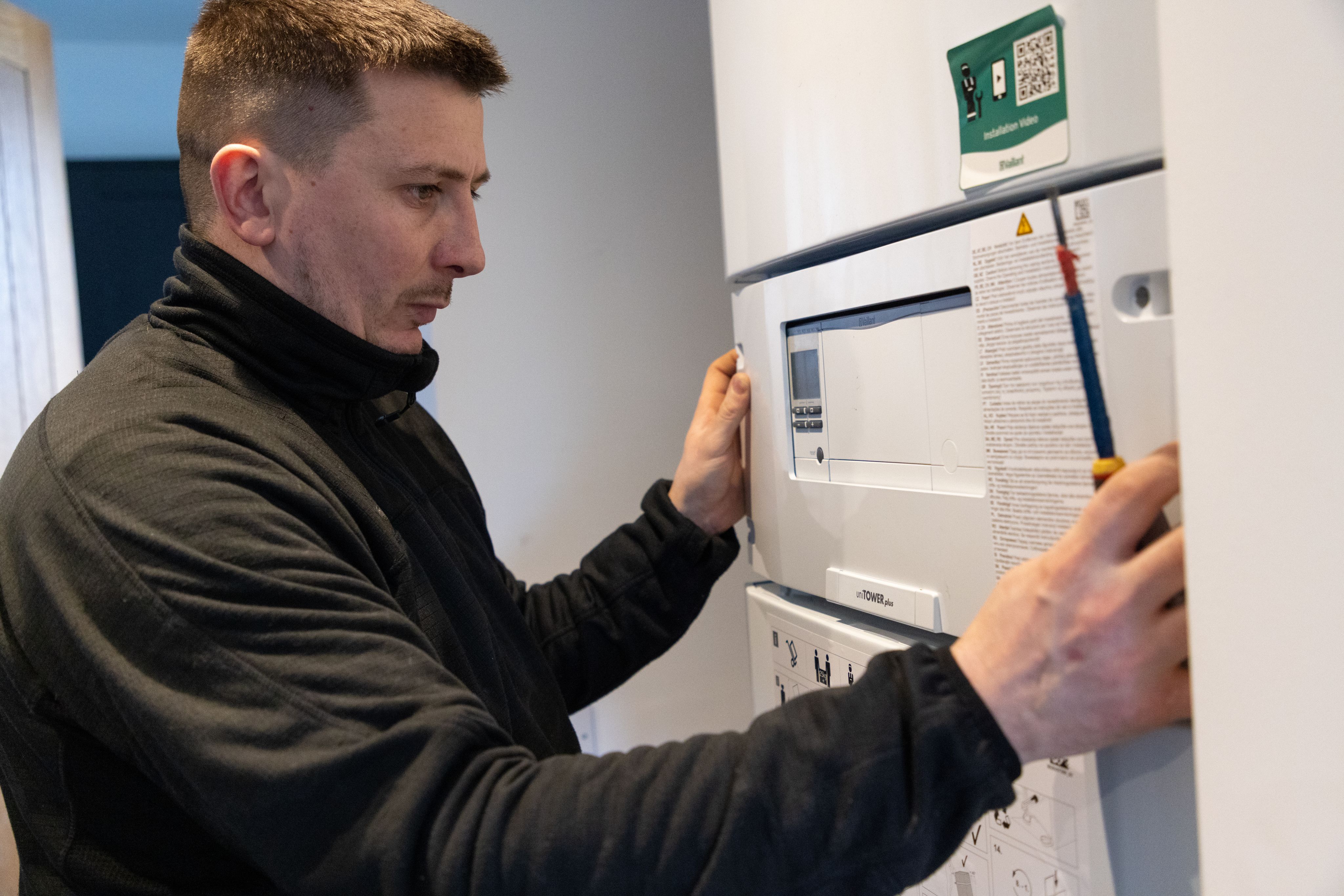
Delivery organisations
Mostly commercial organisations, responsible for the delivery of any shared infrastructure, in-home heating and aftercare. They may also contribute to consultations on the local heat plans and shaping approaches. Although predominantly private sector, this group would also include public sector and community organisations.

Citizens/households
Households will be made aware of the change to low-carbon heating early, and will be consulted at an early stage on plans by the local heat body to influence the design of schemes. They will be informed of upcoming schemes and any potential backstop dates such as gas grid decommissioning or boiler bans.
An overview of coordinated switching
Our current concept for a coordinated switch is illustrated in the diagram below. It outlines the involvement of each group from initial planning to final delivery.
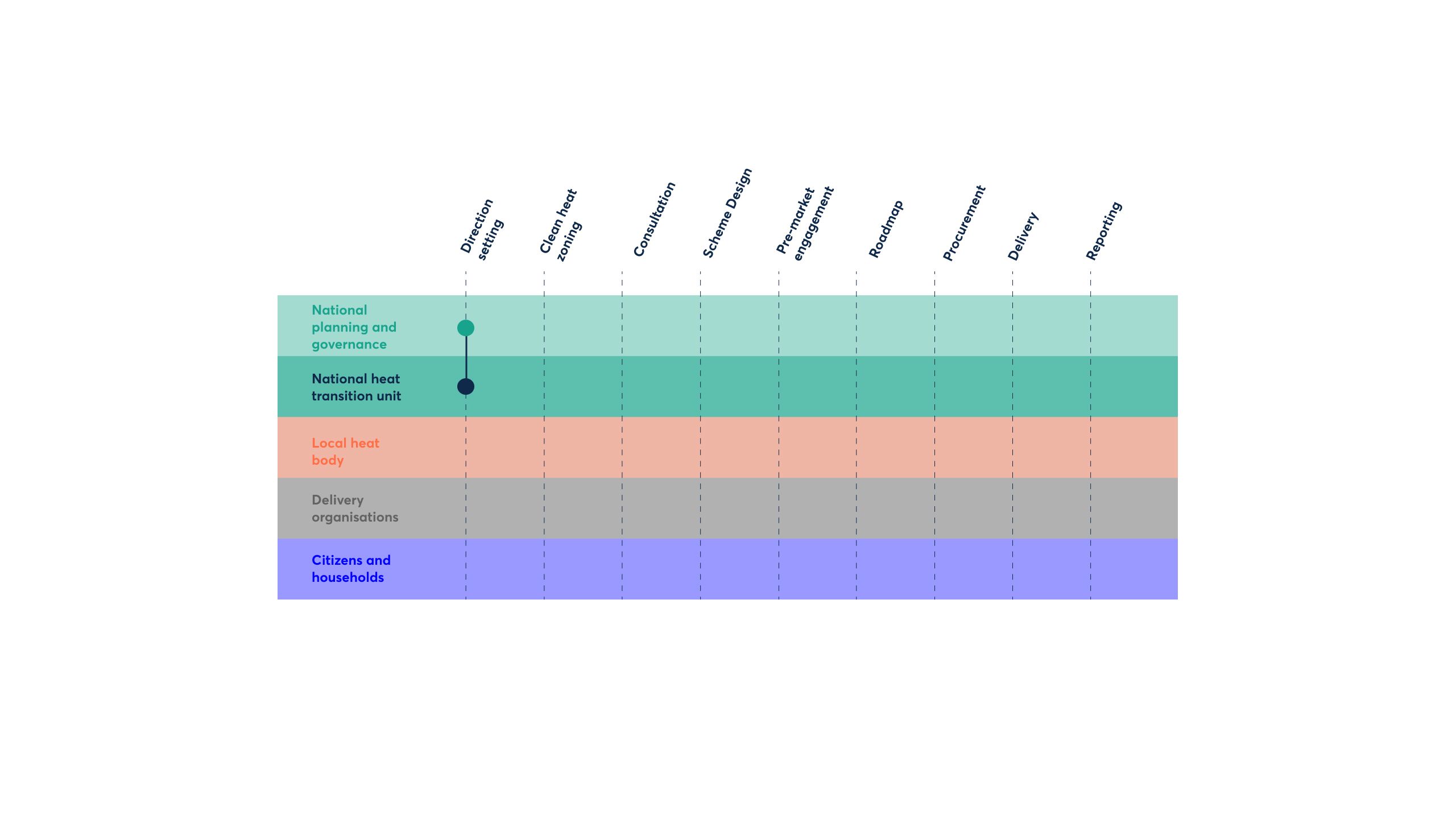
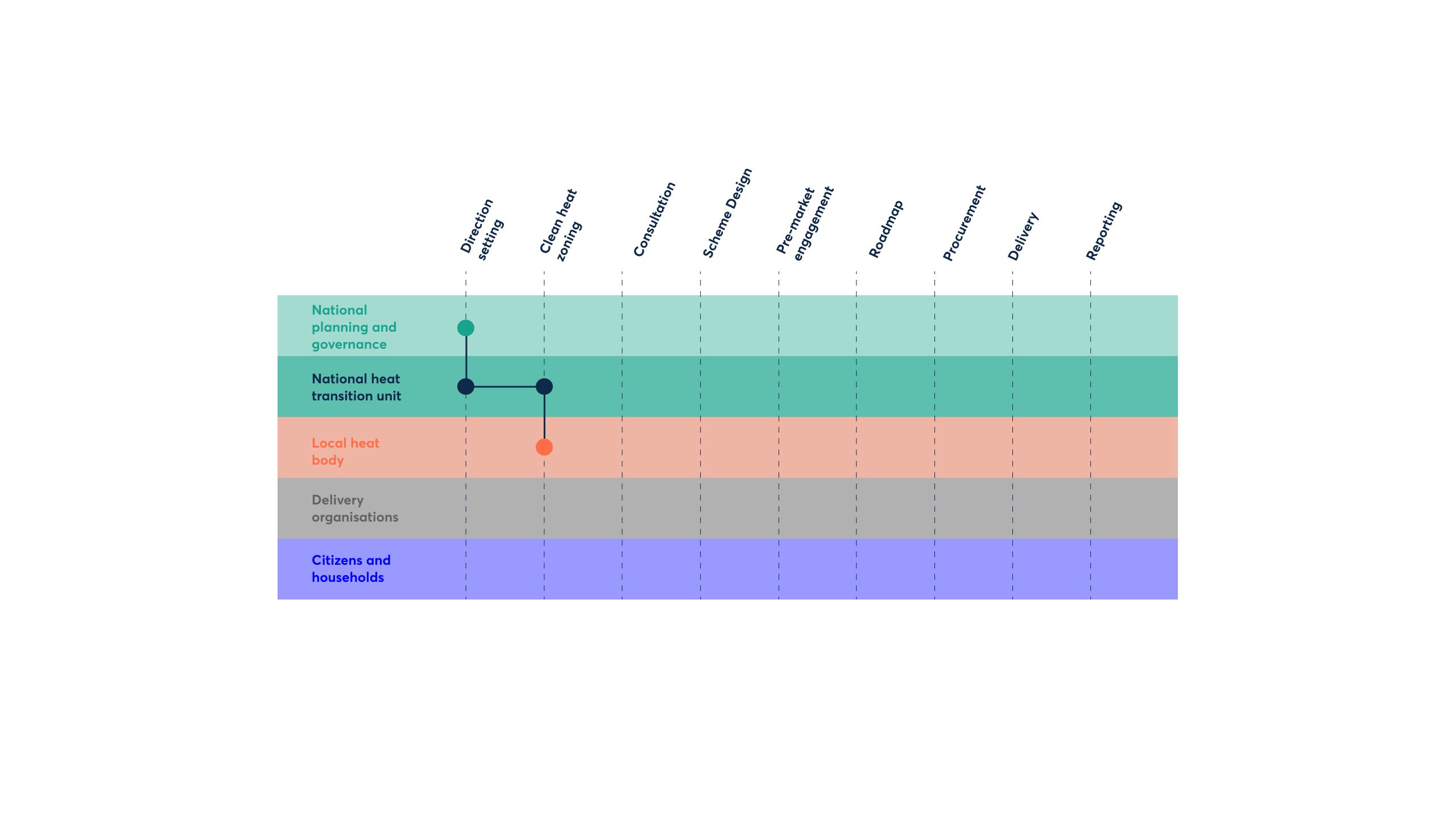
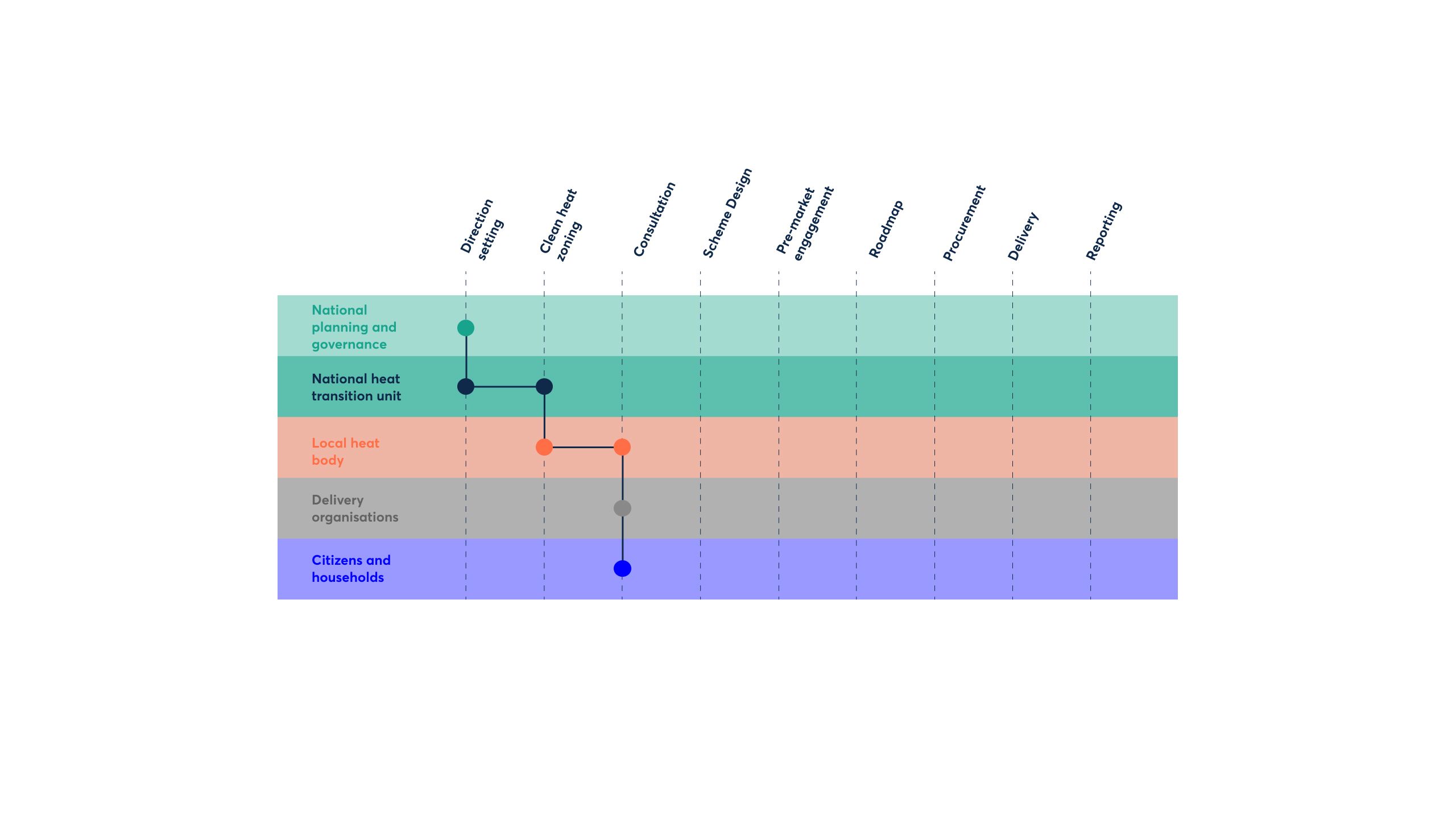
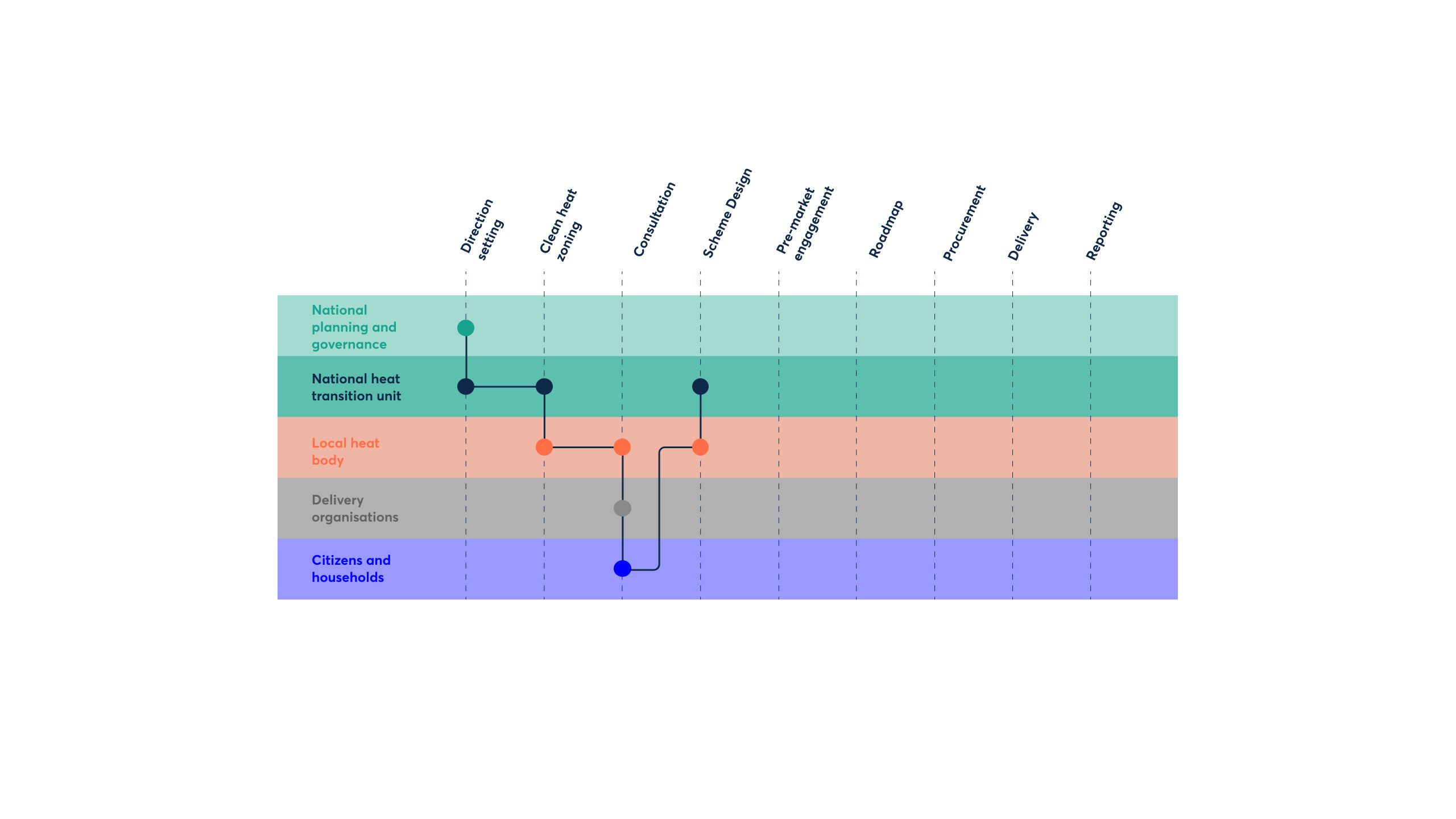
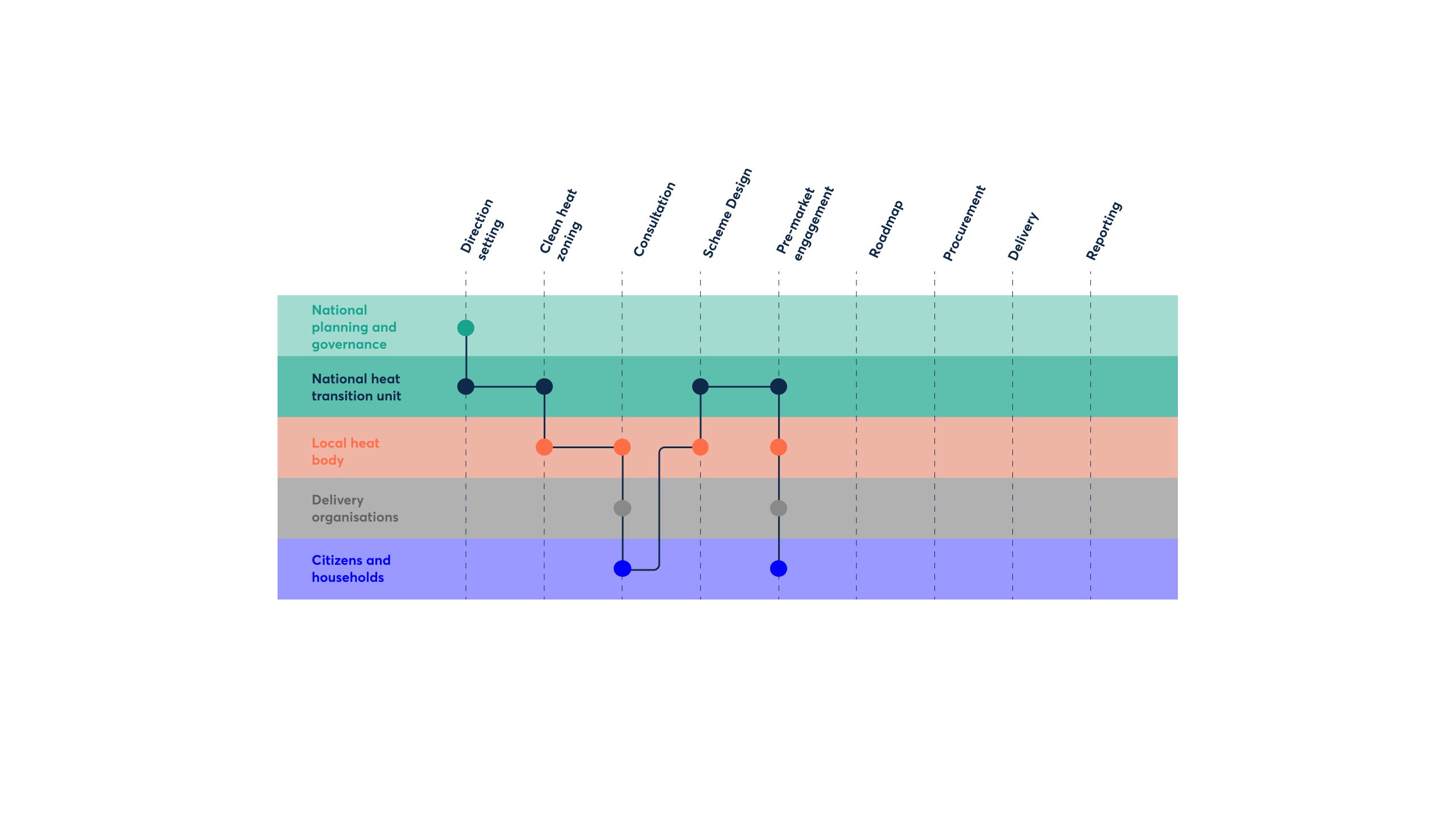
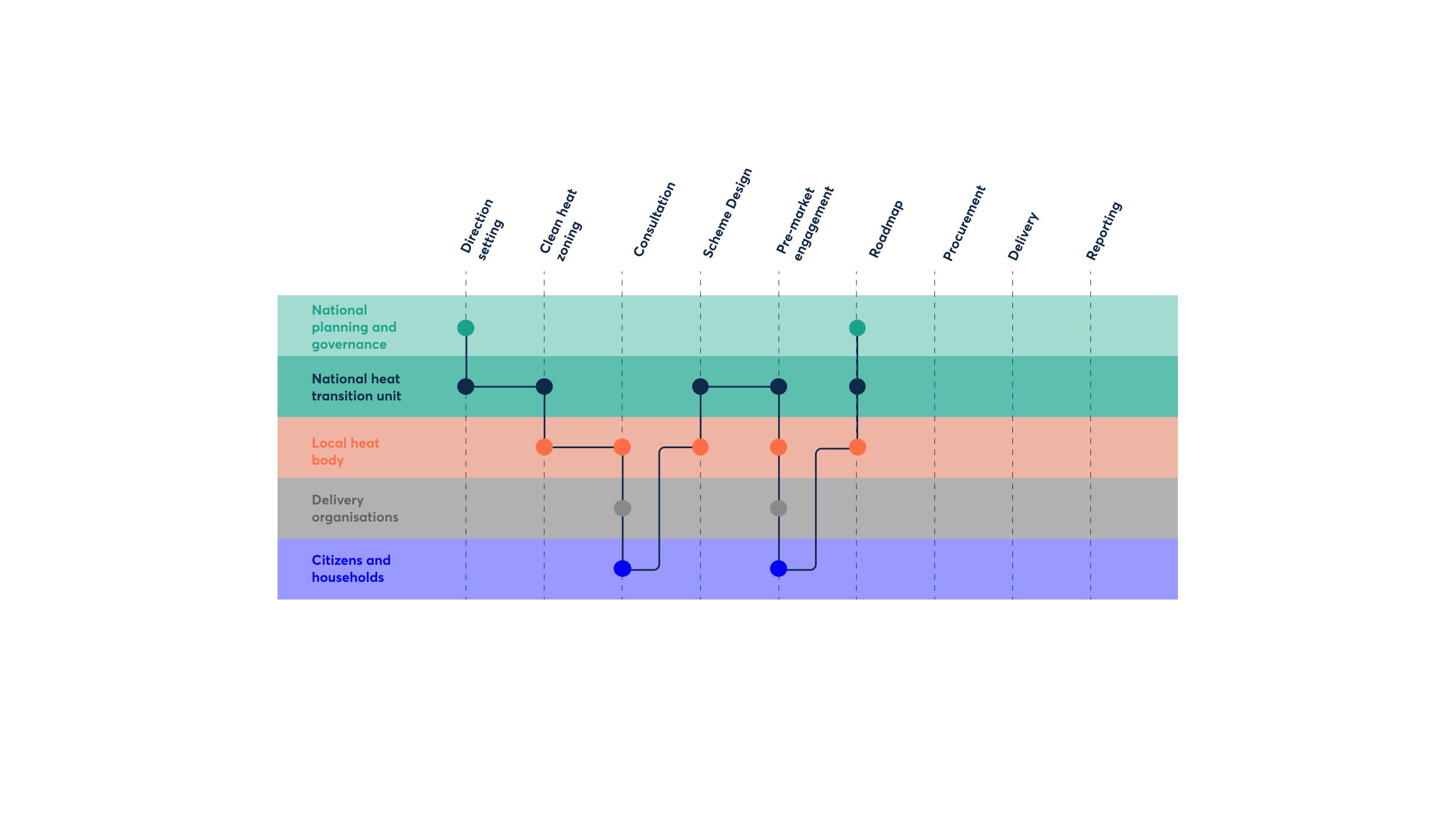
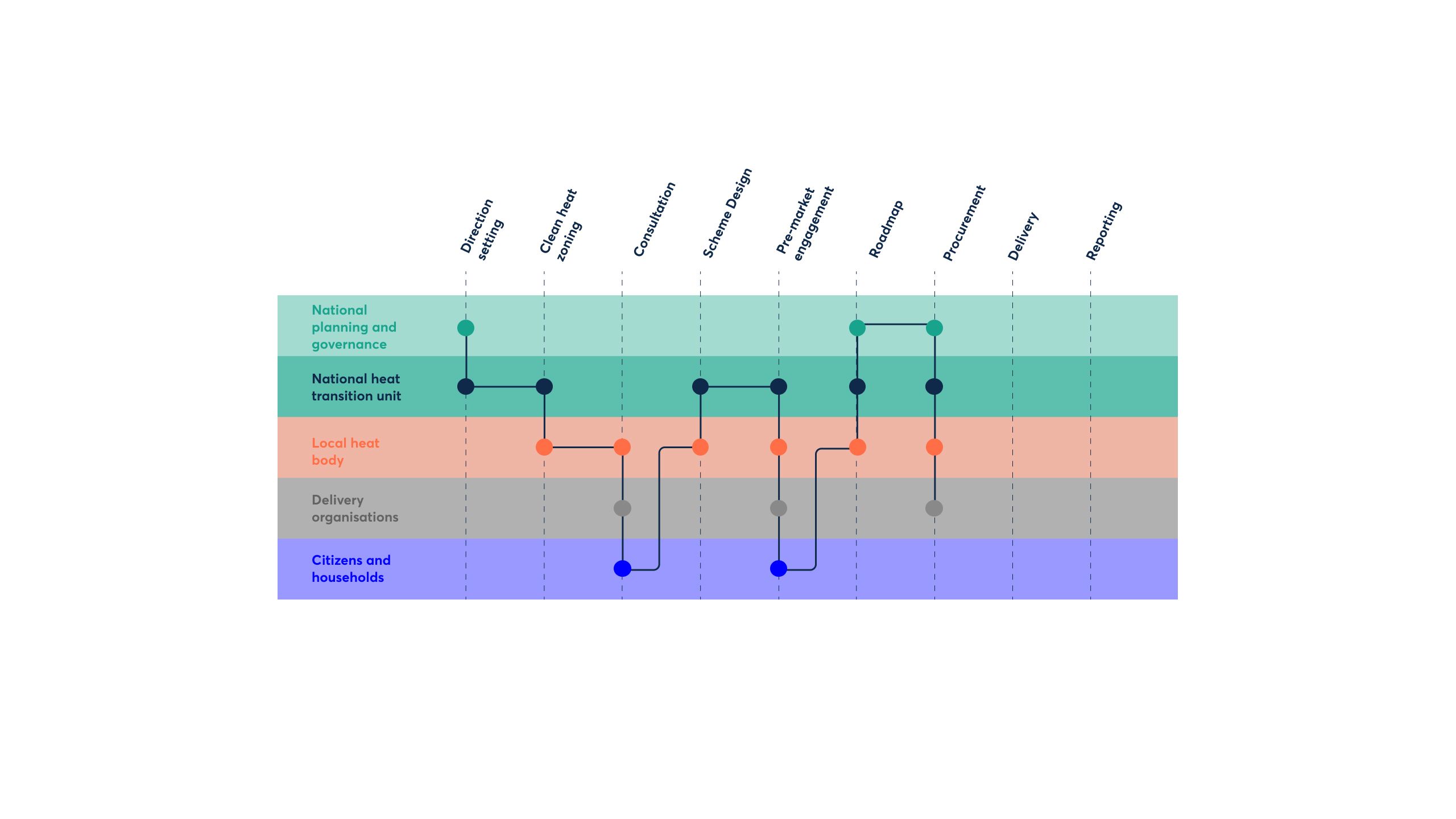
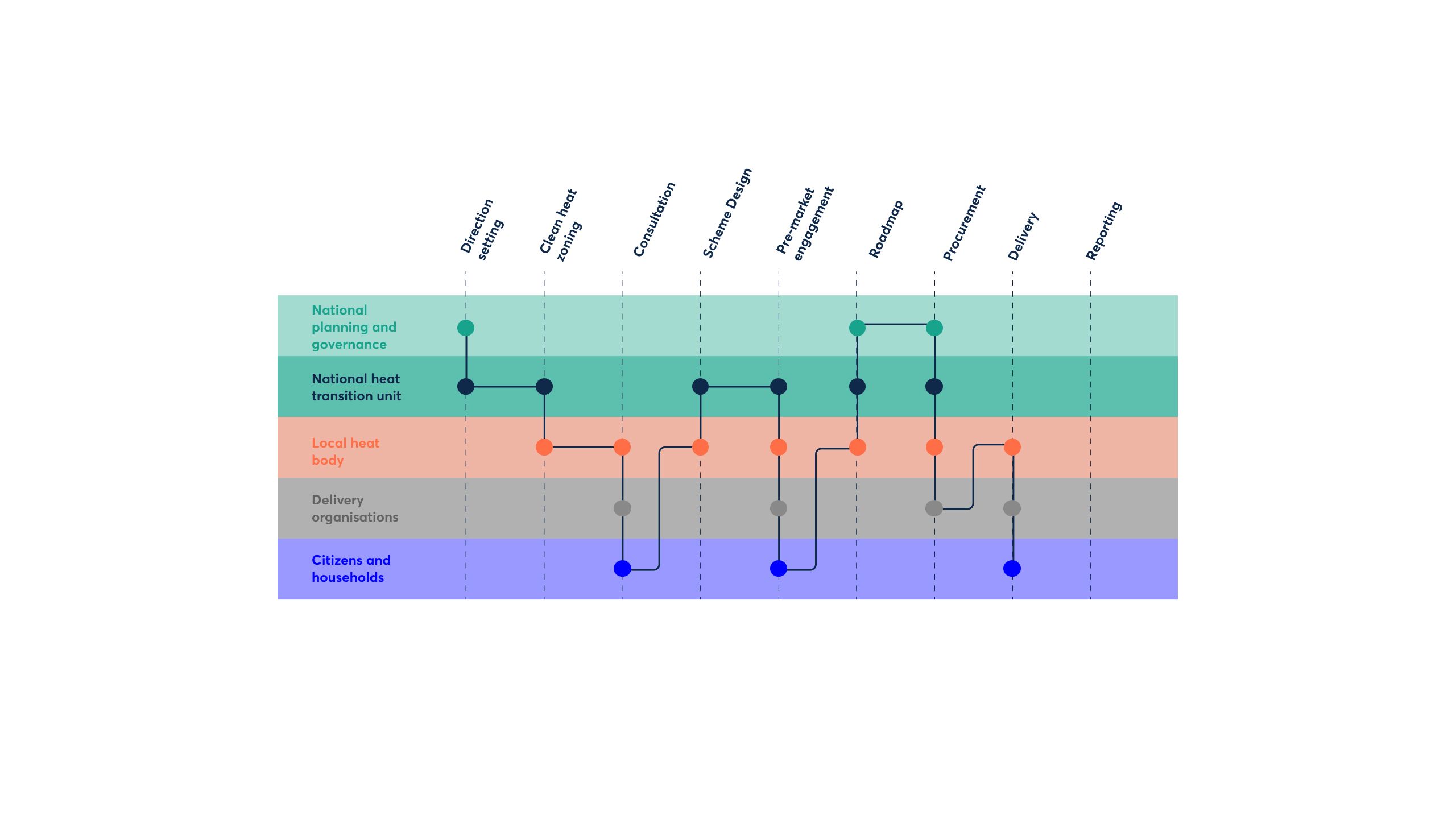
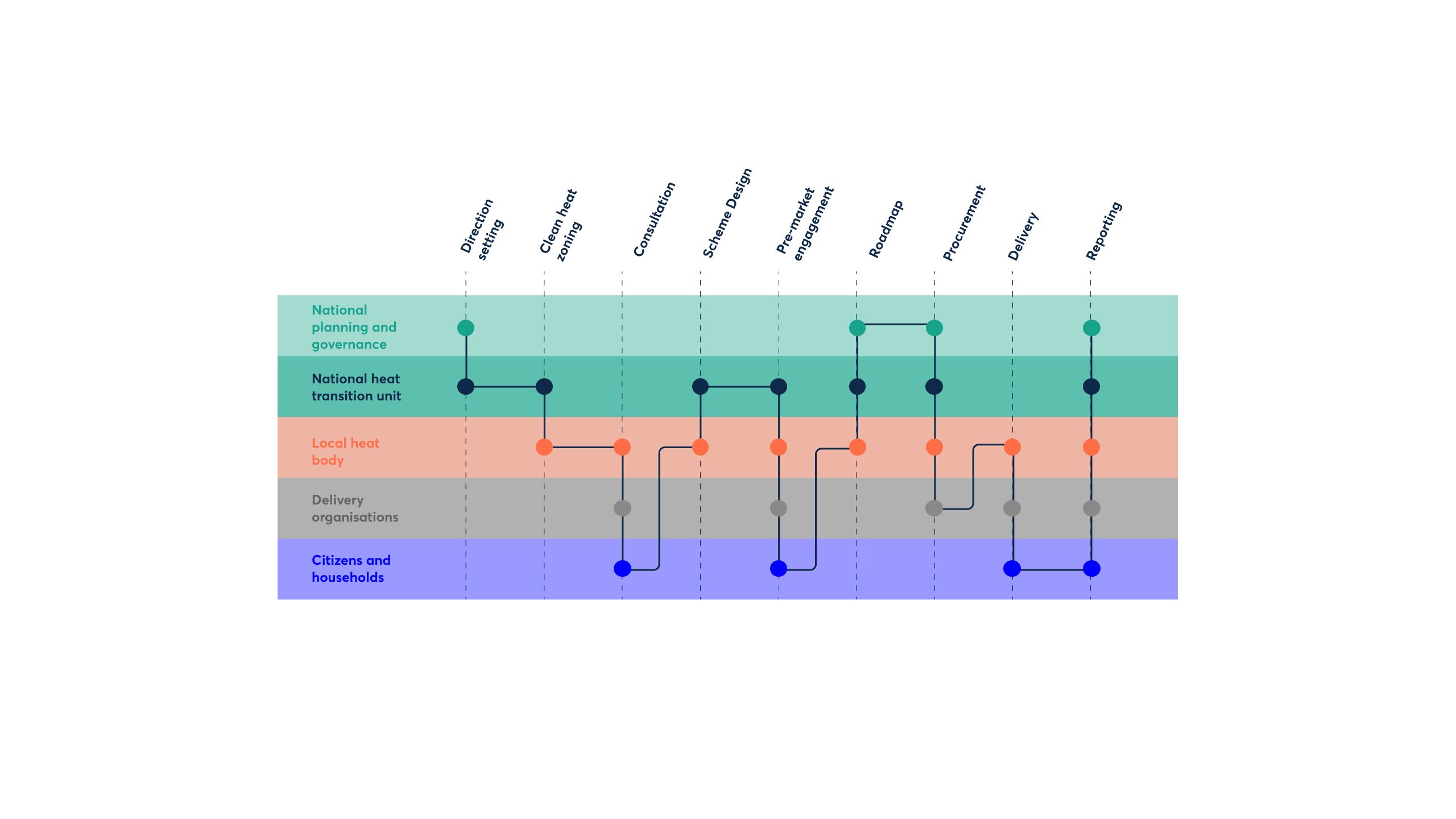
Direction setting: direction, targets and intention would be set at a national level, raising awareness and contributing to confidence within the supply chain.
Clean heat zoning: local heat bodies would start by zoning the areas they’re responsible for. This zoning would build on any pre-existing energy planning and would identify the preferable low-carbon heat technology for areas at a street level.
Consultation: a public consultation would be published by the local heat body with the intention of engaging delivery organisations and citizens. The aim would be to refine zoning.
Scheme design: the local heat body would refine the boundaries of the zones using the consultancy responses. Using resources and templates from the national heat transition unit they would then design draft decarbonised heat schemes for particular areas.
The draft schemes would then form the basis of a further round of consultation and pre-market engagement – preparing both citizens and the private sector for upcoming changes and opportunities.
Pre-market engagement: the pre-market engagement and consultation would influence the prioritisation of schemes that would result in a roadmap.
Roadmap: the roadmap, managed by the local heat body would be shared with regional and national actors to consider wider implications to energy infrastructure. Updates to the roadmap may be required to align with upgrades to electric distribution.
Procurement: an updated roadmap would be published by the local heat body and priority schemes would be put to tender using national procurement portals.
Delivery: contracts would be awarded and schemes would start to be communicated with households. It’s at this point at which the delivery of both communal infrastructure and in-home switches would be delivered.
Reporting: feedback and evaluation should be built into the process and involve individual households, delivery companies and local heat bodies. The responsibility of disseminating any resultant updates to approach and advice should fall to the national heat transition unit.
Our recommendations
We recommend developing this approach gradually, building on existing policy successes such as the heat networks delivery unit. This coordinated approach should aim to gradually scale up over time, complementing the individual-led approach that the UK currently uses.
To scale up a coordinated approach, we recommend the following actions as first steps:
- Develop local heat bodies in as many areas as possible to fill the gap in heat planning and coordination at a local, granular level.
These bodies should develop heat zones and engage in industry and public consultation before identifying more granular deliverable schemes. A primary goal of any introductory period should be to develop an in-depth understanding of the resources, guidance and playbooks required by local areas to deliver these plans.
Bodies should be built from the ground up and be flexible to accommodate the local context. The development of local bodies should build on this work, convening stakeholders to understand their requirements, ultimately de-risking rollout. - Pilot the development of several communal shared infrastructure schemes. The government should fund these pilots in some of the more advanced local areas, most likely to be city regions. These should vary in approach to technology, property and tenure type. The pilots should understand how a scheme could be designed, communicated with households, put to tender and delivered using a competitive bidding process. These pilots should seek to understand to what extent schemes require guarantees by the government to mobilise private finance.
- Pilot a coordinated approach to individual home upgrades. Government should fund these pilots in some more advanced local areas. These pilots should focus on how groups of homes could benefit from switching to individual low-carbon heat sources (i.e. air source heat pumps). The pilots should understand the extent to which local government-led low-carbon heat zoning and planning is enough to signal to households and trigger action. The pilots should test commercially viable offers for collective purchasing and potential partnerships with finance providers. This approach could look similar to the group purchasing of solar panels, operated by a third party in partnership with a local authority.
- Data gathering and feedback loops should be piloted as part of recommendations 2 and 3 above. The role of a national heat transition unit should be examined to ensure that it is providing the best possible support for delivery partners and local government. The pilot should also seek to understand how this information should be integrated back into guidance, playbooks and advice on the formation of teams for local governments.
Alongside these specific recommendations, participants in our workshops also consistently raised a number of wider policy measures which are worth considering:
- reducing the electricity-to-gas price ratio
- setting clearer dates for gas grid decommissioning
- introducing a mandate to connect to communal infrastructure - for new builds, large consumers and building owners, in line with the Department for Energy Security and Net Zero’s current heat network zoning proposals. We do not expect this would apply to existing individual homes.